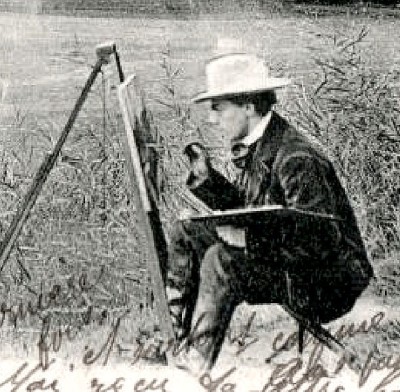
Henri Biva stands as a significant figure in late 19th and early 20th-century French art, celebrated for his evocative landscape paintings and exquisite floral still lifes. Born in Paris on January 23, 1848, and passing away in the same city on February 2, 1929, Biva dedicated his life to capturing the subtleties of nature with remarkable sensitivity and technical skill. His work occupies a fascinating space between the detailed observation of Realism and the light-infused atmosphere of Post-Impressionism, imbued with a strong sense of Naturalism.
Early Life and Artistic Formation
Henri Biva was fortunate to be born into an environment conducive to artistic pursuits. His family background included artists, providing him with early exposure to the world of painting. This familial encouragement likely played a role in his decision to pursue art professionally. He began his formal training relatively young, honing his foundational skills before seeking higher instruction.
His path led him to the prestigious École des Beaux-Arts in Paris, the epicenter of academic art training in France. However, his enrollment might have occurred later than typical, possibly around the age of 25. This period coincided with the tumultuous Franco-Prussian War (1870-1871), and it's plausible that military service during this conflict interrupted or postponed his formal studies. Such experiences often left a mark on artists of that generation, potentially influencing their worldview and artistic sensibilities.
At the École des Beaux-Arts, Biva studied under influential instructors who shaped his artistic direction. Key among them were Léon Tanzi, himself a noted landscape painter, and Alexandre Nozal, another respected landscape artist. Nozal, in particular, is credited with guiding Biva towards specializing in the depiction of natural scenery, recognizing his talent for capturing the essence of the outdoors. This formal training provided Biva with the technical grounding necessary to develop his distinct style.
Influences and Artistic Context
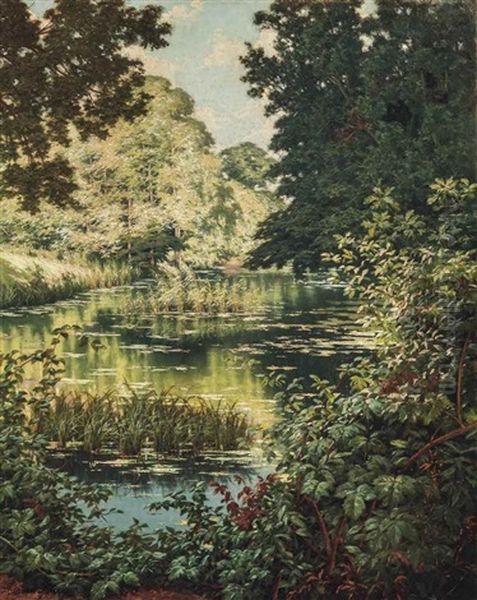
Biva's artistic development occurred during a period of dynamic change and diverse movements within French art. He absorbed influences from several key trends, most notably the 19th-century French Realist movement and the Barbizon School. The Realists, led by figures like Gustave Courbet and Jean-François Millet, emphasized the depiction of ordinary life and landscapes without idealization, focusing on direct observation.
The Barbizon School, active slightly earlier but highly influential, shared this commitment to naturalistic landscape painting. Artists such as Théodore Rousseau, Charles-François Daubigny, and Jean-Baptiste-Camille Corot famously worked directly from nature in the Forest of Fontainebleau, seeking to capture the specific moods and light conditions of the landscape. Biva's dedication to depicting the specificities of nature, particularly the tranquil countryside, clearly echoes the philosophies of these predecessors.
While influenced by Realism and the Barbizon tradition, Biva worked concurrently with the Impressionists, such as Claude Monet, Camille Pissarro, and Alfred Sisley. Although his style retained a greater degree of detail and finish than typical Impressionism, he shared their interest in capturing the effects of natural light and atmosphere. His work can thus be seen as bridging academic traditions with newer approaches, incorporating elements of Post-Impressionism in his brushwork and color sensitivity, perhaps akin in spirit, if not always technique, to later developments seen with artists like Georges Seurat or Paul Signac, who also explored light and color scientifically.
Artistic Style and Techniques
Henri Biva forged a distinctive style characterized by a harmonious blend of meticulous realism and atmospheric sensitivity. His approach is often described as sitting between Post-Impressionism and Realism, with a pronounced naturalistic bent. He possessed a remarkable ability to render detail with precision, yet his paintings never feel sterile or merely photographic. Instead, they are imbued with warmth and life, largely due to his masterful handling of light.
A hallmark of Biva's work is his depiction of natural light, often warm and gentle, filtering through leaves or reflecting off water surfaces. He excelled at capturing the subtle variations in light and shadow, creating a sense of depth and tranquility. His color palette tended towards warm, harmonious tones that enhanced the peaceful, idyllic quality of his scenes. Complex, yet controlled, brushwork contributes to the richness of his surfaces, allowing for both fine detail and suggestive textures.
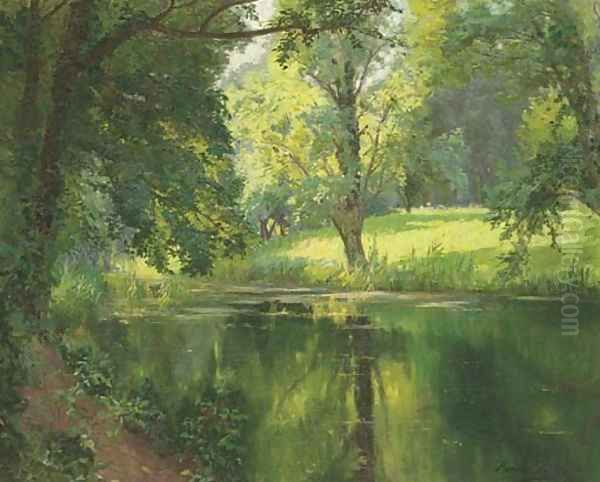
Unlike many Impressionists who focused on capturing fleeting moments and often included signs of modern life or human activity, Biva frequently depicted scenes of pure, undisturbed nature. His landscapes often present the French countryside, particularly the areas west of Paris, as sanctuaries of pre-industrial calm and beauty. He employed traditional painting techniques, often working on canvas with a smooth finish, and practiced painting en plein air (outdoors) to directly observe and capture the nuances of the natural world. Compositionally, he sometimes used framing devices, like dark foreground elements, to draw the viewer's eye into the luminous depths of the scene, a technique hinting at a subtle romantic sensibility.
Subject Matter: Landscapes
Landscapes formed the core of Henri Biva's oeuvre. He was particularly drawn to the serene beauty of the French countryside, finding inspiration in the woods, rivers, and ponds near Paris. Villeneuve-l'Étang, a park near Marnes-la-Coquette, was a recurring subject, offering him tranquil scenes of water and woodland that he rendered with great sensitivity. His landscape paintings often feature water – calm rivers reflecting the sky and trees, quiet ponds dappled with sunlight, or misty morning scenes.
Titles such as Les brumes du matin - Villeneuve-l'Étang (The Mists of Morning - Villeneuve-l'Étang) exemplify his focus on specific atmospheric conditions and locations. This particular work, noted for its delicate rendering of light filtering through morning mist, showcases his ability to evoke a specific mood and time of day. Other works like Woodland Lake or A quiet stretch of the river further illustrate his preference for peaceful, secluded natural settings.
What distinguishes many of Biva's landscapes is the absence of human figures or overt signs of human activity. This deliberate choice emphasizes the pristine, untouched quality of nature, inviting the viewer to contemplate its quiet majesty. His landscapes are not dramatic wildernesses but rather intimate, accessible corners of the natural world, rendered with a deep appreciation for their inherent beauty and tranquility. This focus contrasts with contemporaries like Pissarro, who often depicted rural labor or village scenes.
Subject Matter: Still Lifes
Alongside his landscapes, Henri Biva was a highly accomplished painter of still lifes, particularly floral arrangements. His flower paintings demonstrate the same meticulous attention to detail, sensitivity to light, and harmonious color sense found in his landscapes. He often depicted bouquets in vases or baskets, showcasing a variety of blooms, with roses, sunflowers, and chrysanthemums appearing frequently.
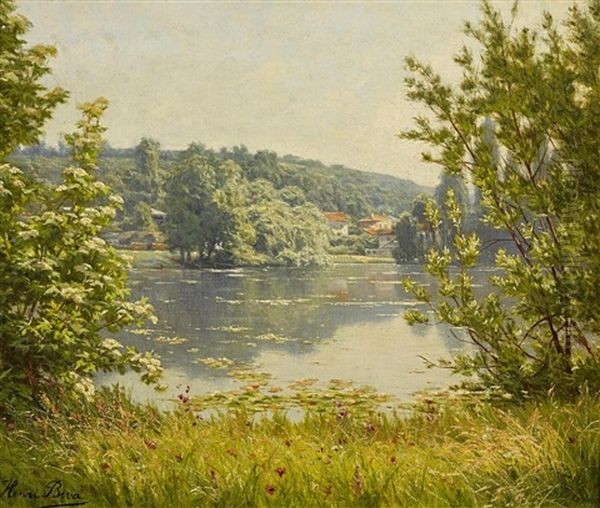
Works like Impression de jardin, fleurs au soleil et panier de roses (Impression of the Garden, Flowers in the Sun and Basket of Roses) and Parc aux tournesols et au spectaculaire Tonnerre (Park with Sunflowers and the Spectacular Tonnerre – likely referring to a type of flower or perhaps a location feature) highlight his skill in this genre. These paintings are characterized by their vibrant yet naturalistic colors, elegant compositions, and the tangible sense of texture in the petals and leaves.
Biva treated his floral subjects with the same reverence he accorded to landscapes. He captured the delicate structure of each flower and the play of light on its surface. His still lifes are more than mere decorative pieces; they are intimate studies of natural forms, celebrating the beauty and transience of flowers. The compositions are often lush and abundant, conveying a sense of nature's bounty. His skill in rendering flowers placed him among the notable still life painters of his time.
Career and Recognition
Henri Biva achieved considerable success and recognition during his lifetime, primarily through the established channels of the Parisian art world. He was a regular exhibitor at the official Paris Salon, the most important art exhibition in France at the time. Participation in the Salon was crucial for an artist's reputation and commercial success. Biva not only exhibited frequently but also garnered numerous awards, testifying to the high regard in which his work was held by the juries and the public.
His accolades at the Salon included an honorable mention in 1892, a third-class medal in 1895, and a second-class medal in 1896. This consistent recognition culminated in him achieving "Hors Concours" status, meaning his work was accepted for exhibition without needing to pass the jury, a privilege reserved for established artists. Further cementing his status, he was awarded a Bronze Medal at the Exposition Universelle (World's Fair) held in Paris in 1900, a major international event. In 1890, his contributions to French art were recognized when he was made a Chevalier of the Legion of Honour, one of France's highest civilian decorations.
Beyond the main Salon, Biva also participated in other exhibitions, such as the Exposition Internationale de Blanc et Noir in Paris (in 1886, 1888, 1890, and 1892), which showcased works in monochrome, indicating his versatility across different media or techniques. His success was not limited to critical acclaim; his paintings found favor with collectors, ensuring a steady market for his work. His career trajectory reflects that of a respected artist working successfully within the established art system of the Third Republic, even as more radical movements like Fauvism and Cubism began to emerge.
Connections and Contemporaries
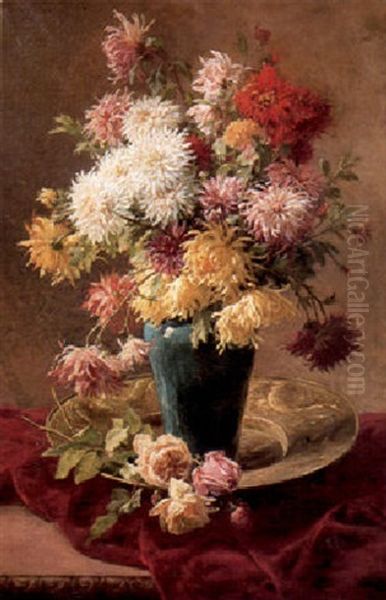
While Henri Biva carved out his own niche, his career unfolded within the rich tapestry of late 19th and early 20th-century French art. His direct mentors were Léon Tanzi and Alexandre Nozal, who grounded him in landscape painting. His work shows the clear influence of the earlier Barbizon painters like Rousseau, Daubigny, and Corot, and the Realism of Courbet and Millet.
He worked during the era of Impressionism and Post-Impressionism, and while his style differed, he was a contemporary of giants like Monet, Pissarro, Sisley, Renoir, Degas, Seurat, and Signac. His adherence to a more detailed, naturalistic style set him apart from the Impressionists' focus on capturing fleeting moments, yet his sensitivity to light connects him to their concerns.
As a successful Salon painter, he exhibited alongside prominent academic artists of the time, such as William-Adolphe Bouguereau and Jean-Léon Gérôme, even though their subject matter (often historical or mythological) and highly polished style differed significantly from Biva's focus on landscape and still life. Biva represents a strand of French painting that maintained a strong connection to naturalistic representation and traditional technique while subtly incorporating contemporary interests in light and atmosphere. The available records do not point towards specific close collaborations or intense rivalries with other major figures, suggesting he pursued his artistic vision with focused dedication.
Legacy and Collections
Henri Biva's legacy rests on his consistent production of high-quality landscape and still life paintings characterized by technical refinement, meticulous detail, and a profound sensitivity to the nuances of natural light and atmosphere. He captured a serene, often idyllic vision of the French countryside that appealed greatly to audiences of his time and continues to resonate with viewers today. His work provides a valuable counterpoint to the more revolutionary artistic movements of his era, demonstrating the enduring appeal of naturalistic representation combined with atmospheric effect.
His influence can be seen in the continuation of the French landscape tradition, potentially inspiring later painters who valued careful observation and the depiction of tranquil nature. While perhaps not as widely known today as the leading Impressionists, his work is held in significant public collections, attesting to its historical importance. Notably, paintings by Henri Biva can be found in the Musée du Louvre in Paris and the Royal Museums of Fine Arts of Belgium in Brussels. Other works are housed in various French regional museums and numerous private collections worldwide.
His dedication to capturing the beauty of the natural world, whether in the expansive vistas of Villeneuve-l'Étang or the delicate petals of a rose, ensures his place as a respected master of French Naturalism. His paintings remain admired for their technical accomplishment and their ability to transport the viewer to moments of peaceful contemplation.
Market Presence
The enduring appeal of Henri Biva's work is reflected in its continued presence and value in the art market. His paintings appear regularly at auctions in Europe and North America, where they attract interest from collectors of late 19th and early 20th-century French art. The market value of his works varies depending on factors such as size, subject matter, condition, provenance, and the specific quality of the piece.
Auction records indicate a range of values. Smaller landscapes or studies might fetch estimates in the lower thousands of euros, as seen with a work like Sommerliche Flusslandschaft (Summer River Landscape), estimated between €2,500 and €3,000. More significant works, particularly large, well-executed floral still lifes or major landscapes, command higher prices. For instance, the large painting Impression de jardin, fleurs au soleil et panier de roses carried an estimate of €14,000 to €18,000. Another work, Dívna v zahradě (likely a landscape or garden scene), had a starting price listed at €21,820 in one instance.
This consistent market activity demonstrates that Biva's paintings are sought after for their aesthetic qualities, technical skill, and representation of a beloved period in French art history. His work offers collectors an accessible entry point into the art of the era, distinct from Impressionism yet sharing its appreciation for light and nature.
Conclusion
Henri Biva was a dedicated and highly skilled painter whose life's work celebrated the quiet beauty of the natural world. Rooted in the traditions of French Realism and the Barbizon School, yet sensitive to the atmospheric concerns of his time, he developed a distinctive style characterized by meticulous detail, warm light, and serene compositions. His landscapes of the Parisian countryside and his elegant floral still lifes earned him significant recognition during his lifetime, including numerous awards at the Paris Salon and the prestigious Legion of Honour. Though perhaps overshadowed in popular history by the more radical innovators of his day, Biva remains an important figure whose paintings offer enduring moments of peace and refined beauty, securing his position as a master of French Naturalist painting. His work continues to be appreciated in museums and private collections, and valued in the art market, a testament to his lasting artistic achievement.